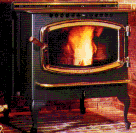Pellet Stoves and Inserts
 Pellet-burning appliances are simpler to operate and more convenient
than other wood-burning appliances. In fact, they are almost as easy to
use as gas, oil, or electric heaters. These stoves and inserts burn wood
pellets--compressed wood which resembles rabbit food.
Pellet-burning appliances are simpler to operate and more convenient
than other wood-burning appliances. In fact, they are almost as easy to
use as gas, oil, or electric heaters. These stoves and inserts burn wood
pellets--compressed wood which resembles rabbit food.
Typical Pellet Stove
Pellet-burning appliances rely on sophisticated computers and circuit boards
to determine how much pellet fuel should be burned. Most models have at
least two burn settings and some use thermostats to control the fire. They
also use a forced-air system to distribute heat. Pellet-burning appliances
are highly efficient and pollute very little. Depending on the model, they
may furnish between 10,000 and 50,000 Btu per hour.
 Wood Pellets
Wood Pellets
Because these appliances burn wood so efficiently, some do not even need
chimneys. Rather, they exhaust fumes through a small hole in the wall to
the outdoors. Pellet-burning appliances need to be refueled less frequently
than most other wood-burning appliances. Refueling varies from once a day
to twice a week, depending on the model and your heating needs. To refuel,
you simply pour the pellets into a hopper, which holds between 35 and 130
pounds of pellets and they are transferred to the fire chamber to be burned
as needed. A corkscrew-shaped device called an auger transfer pellets to
the fire chamber. There are two types of auger feed systems, bottom-fed
and top-fed loading systems. Unlike other wood-burning appliances, pellet
stoves and inserts rely on mechanical air-supply systems (usually a forced-draft
or induced-draft system) to vent air from the home. the forced-draft system
uses a fan to force air up the vent into the combustion chamber. The induced-draft
system, sometimes called the negative pressure system, uses a fan to draw
air from the combustion area through the exhaust system.
Burning wood with a pellet stove or insert is usually convenient, neat and
safe. These devices usually don't require refueling more than once a day
and the fuel is compressed and bagged for clean and easy storage and handling.
Pellet stoves produce virtually no smoke, and produce less odor than other
wood-burning appliances. Moreover, the exteriors of these appliances are
not used for radiating heat and stay relatively cool, preventing you from
burning yourself if you accidentally touch the stove.
Pellet-burning appliances, however, have disadvantages. Because using pellets
is a relatively new way to burn wood, you may have difficulty finding a
dealer who sells the fuel. Before purchasing a pellet-burning appliance,
make sure that a reliable supplier sells pellets in your area. Many of the
pellet fuel and pellet stove manufacturers are located in the Northwest
and the Rocky Mountain region. There are however, retailers throughout the
nation. To find a pellet fuel distributor in your area, ask a local wood
stove dealer or check for a listing in your local telephone directory under
Fuel or Pellet Fuel. Pellet-burning appliances also use several internal
fans, which require about 100 KWH of electricity each month. The need for
electricity will add to your total energy bill and will also prevent you
from using your stove or insert if the power goes out (unless your appliance
has a battery pack). Moreover, there are restrictions on where you can place
a pellet-burning appliance to allow proper combustion and air exchange.
For example, you may not install a pellet stove in a new manufactured (mobile)
home according to regulations of the U.S. Department of Housing and Urban
Development.
Most pellet-burning appliances cost between $1,200 and $2,100. If you are
comparing the price of a pellet stove or insert with another wood-burning
appliance , you should compare the total installed cost of both systems.
If the pellet-burning appliance doesn't need a chimney, the cost of the
entire system may be less than that of another stove. Wood pellets are usually
available in 40 pound bags at about $3.00 each.
 Pellet-burning appliances are simpler to operate and more convenient
than other wood-burning appliances. In fact, they are almost as easy to
use as gas, oil, or electric heaters. These stoves and inserts burn wood
pellets--compressed wood which resembles rabbit food.
Pellet-burning appliances are simpler to operate and more convenient
than other wood-burning appliances. In fact, they are almost as easy to
use as gas, oil, or electric heaters. These stoves and inserts burn wood
pellets--compressed wood which resembles rabbit food. Wood Pellets
Wood Pellets